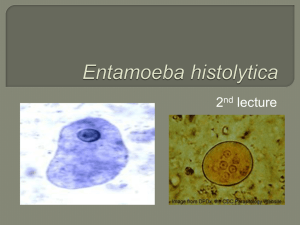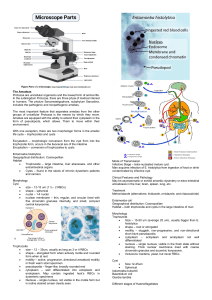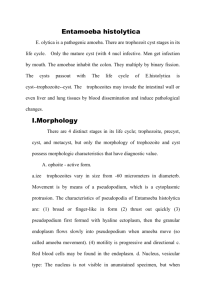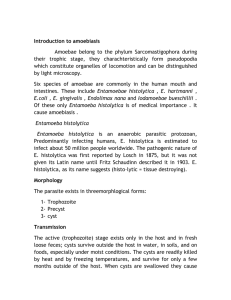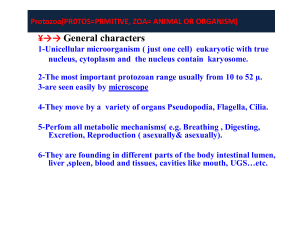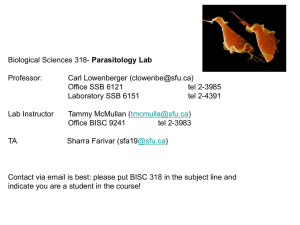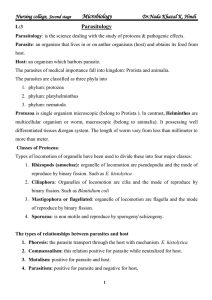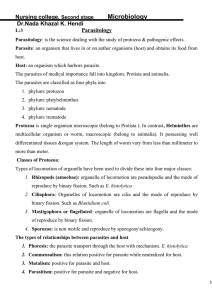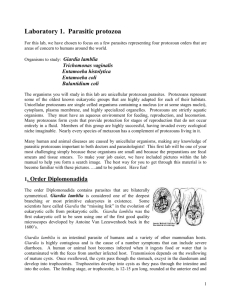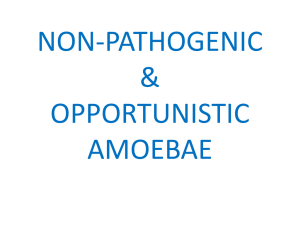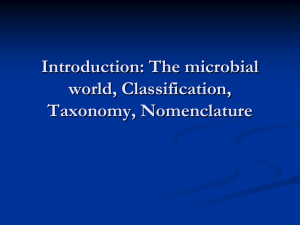E. histolytica
advertisement
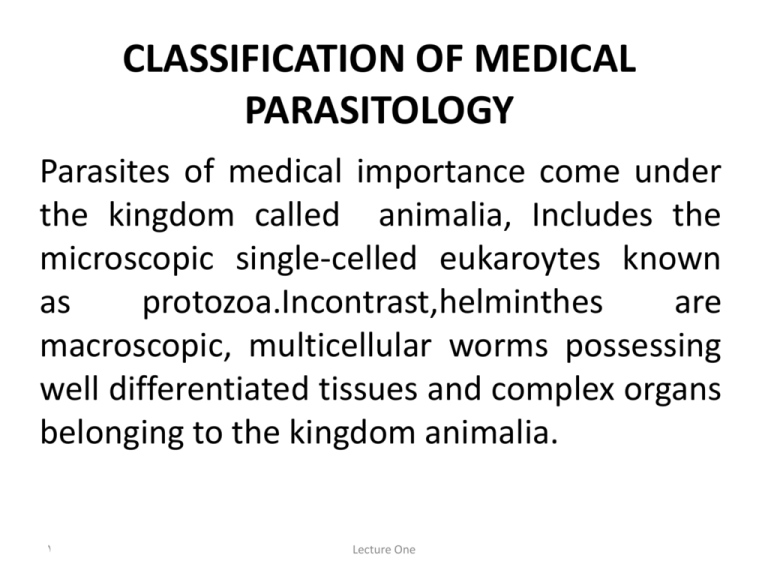
CLASSIFICATION OF MEDICAL PARASITOLOGY Parasites of medical importance come under the kingdom called animalia, Includes the microscopic single-celled eukaroytes known as protozoa.Incontrast,helminthes are macroscopic, multicellular worms possessing well differentiated tissues and complex organs belonging to the kingdom animalia. 1 Lecture One • MedicalParasitology is generally classifiedinto: • Medical Protozoology - Deals with the study of medically important protozoa. • Medical Helminthology - Deals with the study of helminthes (worms) that affect man. • Medical Entomology - Deals with the study of arthropods which cause or transmit disease to man. 2 Lecture One Classification of Medically important Parasites The parasite divide into three main groups Protozoa Parasite consist of a single celled organism which is morphologically and functionally complete and can perform all function of life ,reproduction by asexual or sexual 3 Metazoa Parasite consiste of multicellular celles, Bilaterally symmetrical animals,having welldifferentiated tissues and complex organ Lecture One Arthropoda(Medic Entomology) al include Insecta (Butter fly) Arachnida (Mite) Crustacea (Cyclops) Taxonomic classification of Protozoa Sub kingdom Protozoa 4 Phylum Class Genusexamples Speciesexamples Sarcodina(Amoeba) move by pseudopodia Entamoeba Endolimax Iodameba Dientameba E. hstolytica E.nana I.butchlii D.fragilis Mastigophora (Flagellates) move by flagella Giardia Trichmonas Trypanosoma Leishmania G. Lamblia T.vaginalis T.brucci L.donovani Apicomplexa (Sporozoa) no organelle of Locomotion Plasmodium Toxoplasma P. falciparum T.gonidi C.parvum I.beli Ciliophora move by cillia Balantidium Sarcomastigophora further divided into Cryptosporidium Isospora Lecture One B. coli Important pathogenic protozoa and commonly caused diseases. Type and location Species Disease Species Disease Intestinal tract Entamoeba histolytica Giardia lamblia Cryptosporidium parvum Balantidium coli Isospora belli Cyclospora cayentanensis Ambiasis Giardiasis Cryptosporidiosis Balantidiasis Isosporiosis Cyclosporiasis Urogenital tract Trichomonas vaginalis Trichomoniasis Blood and tissue Plasmodium species Toxoplasma gondii Trypanasoma species Leishmania species Naegleria species Acanthamoeba species Babesia microti Malaria Toxoplasmosis Trypanosomiasis Leishmaniasis Amoebic Meningoencephalitis Amoebic Meningoencephalitis Babesiosis 5 Lecture One The Protozoa General: • There are about 45,000 protozoan species; around 8000 are parasitic, and around 250 species are important to humans. • Diagnosis - must learn to differentiate between the harmless and the medically important. This is most often based upon the morphology of respective organisms. • Transmission - mostly person-to-person, via fecal-oral route; fecally contaminated food or water; other means include sexual transmission, insect bites or insect feces. 6 Lecture One The Protozoa Diagnostic Features: • Nuclear structure - important in species differentiation. • Size - helpful in identifying organisms; must have calibrated objectives on the microscope in order to measure accurately. • Cytoplasmic inclusions - chromatoid bars (coalesced RNA); red blood cells; food vacuoles containing bacteria, yeast, etc. • Appearance of cytoplasm - smooth & clean or vacuolated. • Type of motility - directional or non-directional; sluggish or fast. 7 Lecture One The Protozoa Nuclear Structure: • Chromatin - nuclear DNA. Present as “peripheral” chromatin and the karyosome. • Karyosome - a small mass of chromatin within the nuclear space. Also called “endosome” or “centrosome.” • Peripheral Chromatin - chromatin adhering to the nuclear membrane. • Nuclear membrane - membrane surrounding all nuclear material. Chromatoid body or “bar” - coalesced RNA within the cytoplasm of the cyst stage. 8 Lecture One The Protozoa General: • Trophozoite - the motile vegetative stage; multiplies via binary fission; colonizes host. • Cyst - the inactive, non-motile, infective stage; survives the environment due to the presence of a cyst wall. Cysts do not multiply, however, some organisms divide within the cyst wall. 9 Lecture One They are three groups of Amoeba Pathogenic :E. histolytica 10 Nonpathogenic ;Entamoeba coli E.gingivalis Endolimax nana Iodameba butschili Dientameba fragilis Lecture One Free Living Neagleria fowleria Pathogenic Amoeba Entamoeba histolytica • INTRODUCTION • Amoebas primitive unicellular microorganisms with a relatively simple life cycle which • can be divided into two stages: • Trophozoite : actively motile feeding stage • Cyst : quiescent,resistanse ,infective stage • The reproduction is through binary fission • Motility by extention of pseudopodia (False Feet) 11 Lecture One Trophozoite :Viable trophozoites vary in size from about 10-60μm in diameter. Motility is rapid,progressive, and unidirectional,through pseudopods. The nucleus is characterized by evenly arranged chromatin on the nuclear membrane and the presence of a small,compact, centrally located karyosome. The cytoplasm is usually described as finely granular with few ingested bacteria or debris in vacuoles. In the case of dysentery,however, RBCs may be visible in the cytoplasm, and this feature is diagnostic forE.histolytica. 12 Lecture One Cyst : (infectivestage) • Cysts range in size from 1020μm. contains four nuclei when mature The immature cyst has inclusions namely; glycogen • mass and chromatoidal bars. As the cyst matures, the glycogen completely disappears; • the chromotiodials may also be absent in the mature cyst.. 13 Lecture One Life cycle of E. histolytica Infection by E. histolytica occures by ingestion of cyst in fecally contaminated food,water or hands,the cyst resistane to the gastric environmentand passes to small intestine where it excystation Trophozoite are released which migrate to large intestine ,the troph. Multiply by binary fission and produce cyst (Mature or immature) which are passed in feces, (trophozoite can be passed in diarrheal stool,but rapidly destroyed outside the body,the troph.remain confined to the intestinal lumen , in some individuals troph. non invade the intestinal who are thus asymptomatic carriers but in other patient troph. Invade the intestinal submucosa causes intestinal disease (lesion,Ulcer,Flaske shape ) or Invasion of blood vessels leads to secondary extra intestinal lesions.May be invade liver, lung and brain.the cyst can survive days to weeks in the external environment and are responsible for transmission. 14 Lecture One life cycle of E.histolytica 15 Lecture One Epidemiology E.histolytica has a worldwide distribution. Although it is found in cold areas, theincidence is highest in tropical and subtropical regions that have poor sanitation and contaminated water. About 90% of infections are asymptomatic, and the remaining produces a spectrum of clinical syndrome. Patients infected withE.hisolytica pass non infectious trophozotes and infectious cysts in their stools. Therefore, the main source of water and food contamination is the symptomatic carrier who passes cysts. Symptomatic amebiasis is usually sporadic. The epidemic form is a result of direct person-to-person faecal-oral spread under conditions of poor personal hygiene 16 Lecture One Pathogenesis Trophozoites divide and produce extensive local necrosis in the large intestine. Invasion into the deeper mucosa with extension into the peritoneal cavity may occur. This canlead to secondary involvement of other organs, primarily the liver but also the lungs,brain, and heart. Extraintestinal amebiasis is associatedwithtrophozoites. Amoebasmultiply rapidly in an anaerobic environment, because the trophozites are killed by ambient oxygen concentration. 17 Lecture One Clinical features The outcome of infection may result in a carrier state, intestinal amebiasis, or exteraintestinal amebiasis. Diarrhoea, flatulence, and cramping are complaints of symptomatic patients. More severe disease is characterised by the passing ofnumerous bloody stools in a day. Systemic signs of infection (fever, leukocytosis, rigors)are present in patients with extraintestinal amebiasis. The liver is primarily involved,because trophozoites in the blood are removed from the blood by the portal veins. Theright lobe is most commonly involved, thus pain over the liver with hepatomegaly and elevation of the diaphragm is observed. 18 Lecture One Laboratory diagnosis In intestinal amoebiasis: • Examination of a fresh dysenteric faecal specimen or rectal scraping fortrophozoite stage. (Motile amoebae containing red cells are diagnostic of amoebicdysentery). • Examination of formed or semiformed faeces for cyst stage. (Cysts indicateinfection with either a pathogenic E.histolytica or non-pathogenic E.dispar.) Extraintestinal amoebiasis • Diagnosed by the use of scanning procedures for liver and other organs. • Specific serologic tests, together with microscopic examination of the abscess material, can confirm the diagnosis. 19 Lecture One Treatment Acute, fulminating amebiasis is treated with metrondiazole followed by iodoquinol, andasymptomatic carriage can be eradicated with iodoquinol, diloxanide furoate, or paromomycin. The cysticidal agents are commonly recommended for asymptomaticcarriers who handle food for public use,Metronidazole, chloroquine, and diloxanide furoate can be used for the treatment ofextra intestinal amoebiasis. 20 Lecture One OTHER AMEBAE INHABITING THE ALIMENTARY CANAL Entamoeba coli the life cycle stages include; trophozoite, precyst, cyst, metacyst, and metacystic trophozoite. Typically the movements of trophozoites are sluggish, withbroad short pseudopodia and little locomotion, but at a focus the living specimen cannot be distinguished from the active trophotozoite of E.histolytica. However, the cysts are remarkably variable in size. Entamoeba coli is transmitted in its viable cystic stage through faecal contamination. Ε.coli as a lumen parasite is nonpathogenic and produces no symptoms. The mature cyst (with more than four nuclei) is the distinctive stage to differentiate E.coli from the pathogenic E.histolytica. Specific treatment is not indicated since this amoeba is non-pathogenic. The presence of E.coli in stoolspecimen is evidence for faecal contamination. Prevention depends on better personal hygiene and sanitary disposal of human excreta. 21 Lecture One E. histolytica Troph.( 18 – 60 µm ) The motile in saline, active progressive and directional E. Coli Troph. ( 20 – 50 µm ) The motile in saline sluggish rarely progressive not directional 22 Lecture One Table : Differentiation of trophozoite and cyst of E. histolytica and E. coli Note : as E. coli is more commonly found in the dysenteric stool, the morphological differences from the pathogenic species E. histolytica is shown in the table below Entamoeba histolytica Trophozoiti. Size : Motility : Cytoplasm : Cytoplasmic inclusions : Nucleus : Stained with iodine : Nuclear character : 23 20 to 30µm. Very active Clearly defined into ectoplasm and endoplasm. In food vacuoles, Red blood cells, leucocytes and tissue debris but no bacteria Not visible in unstained preparation . Central karyosome; fine chromatin granules line the delicate nuclear membrane . Lecture One Entamoeba coli 20 to 40 µm. Sluggish Not defined; ectoplasm . Bacteria and other materials but never red blood cells . visible in unstained preparation . Eccentric karyosome; coarse chromatin granules line the thick nuclear membrane . Entamoeba histolytica cyst : Stained with iodine : Size : Nucleus : Glycogen mass : 6 to 15 µm. 1 to 4 central karyosome. Visible in uninucleate stage . Chromatoid bodies : Rounded bars . E. histolytica Cyst ( 5 – 20 µm ) 24 Lecture One Entamoeba coli 15 to 20 µm. 1 to 8 eccentric karyosome . Large and visible in the binucleate stage. Filamentous, thread – like with square or pointed ends . E. Coli Cyst ( 15 – 33 µm ) Entamoeba hartmanni (non pathogenic) In all of its life–cycle stage, E.hartmanni resembles E.histolytica except in size, yet there is a slight overlap in the size range. The trophozoites do not ingest red blood cells, and their motility is generally less vigorous than that of E.histolytica. As in other amebae, infection is acquired by ingestion of food or water contaminated with cyst-bearing faeces. Identification is based on examination of small amebae in unstained or iodinestained preparations. Usually no treatment is indicated,measures generally effective against faecalborne infections will control this amoebic infection 25 Lecture One Entamoeba polecki a relatively cosmopolitan parasite of hog and monkey. It can cause human disease but is rarely isolated. The disease is manifested as mild, transientdiarrhoea. The diagnosis of E.polecki infection is confirmed by the microscopic detection of cysts in stool specimens. Treatment is the same as for E.histolyticainfection. Prevention is achieved by good personal hygiene. 26 Lecture One Endolimax nana Is a lumen dweller in the large intestine, primarily at the cecal level,where it feeds on bacteria. The life cycle is similar to E.histolytica. Motility is typically sluggish. Human infection results from ingestion of viable cysts in polluted water or contaminated food. Typical ovoid cysts of E.nana are confirmative. Rounded cysts and living trophozoites are often confused with E.hartmanni and E.histolytica. No treatment is indicated for this nonpathogenicinfection. Prevention can be achieved through personal cleanliness and community sanitation. 27 Lecture One Endolimax nana • live in large intastine smallest amoeba •Life cycle is similar to E.histolytica •Troph.has large karyosome •Feed on bacteria Cyst is small in size ,oval or spherical in shape contain four nuclei 28 Lecture One Iodamoeba buetschlii: the natural habitat is the lumen of the large intestine, the principal site probably being the caecum. The trophozoite feeds on enteric bacteria; it is a natural parasite of man and lower primates. It is generally regarded as a nonpathogenic lumen parasite. No treatment is ordinarily indicated. Prevention is based ongood personal hygiene and sanitation in the community. 29 Lecture One Entamoeba gingivalis only the trophozoite stage presents,all species oral and encystation probably does not occur. E.gingivalis is a commensal, living primarily on exudate from the margins of the gums, and thrives best on unhealthy gums. No specific treatment is indicated. However the presence of E.giingivalis suggests a need for better oral hygiene. 30 Lecture One Blastocystis hominis is an inhabitant of the human intestinal tract previously regarded as non-pathogenic . Its pathogenecity remains controversial. The organism is found in stool specimen from asymptomatic people as well as from people with persistent diarrhoea. B.hominis is capable of pseudopodia extension and retraction, and reproduces by binary fission or sporulation. The classic form that is usually seen in the human stool specimen varies tremendously in size, from 6-40μm. There are thin –walled cysts involved in autoinfection, and thick–walled cysts responsible for external transmission via the faecal-oral route. The presence of large numbers of these parasites(five or more per oil immersion microscopic field) in the absence of other intestinal pathogens indicates disease. Treatment with iodoquinol or metronidazole has been successful . 31 Lecture One FREE-LIVING AMOEBAE Among the numerous free-living amoebae of soil and water habitats, certain species of Naegleria, Acanthamoeba and Balamuthia are facultative parasites of man. Most human infections of these amoebae are acquired by exposure to contaminated waterwhile swimming. Inhalation of cysts from dust may account for some infections. 32 Lecture One
